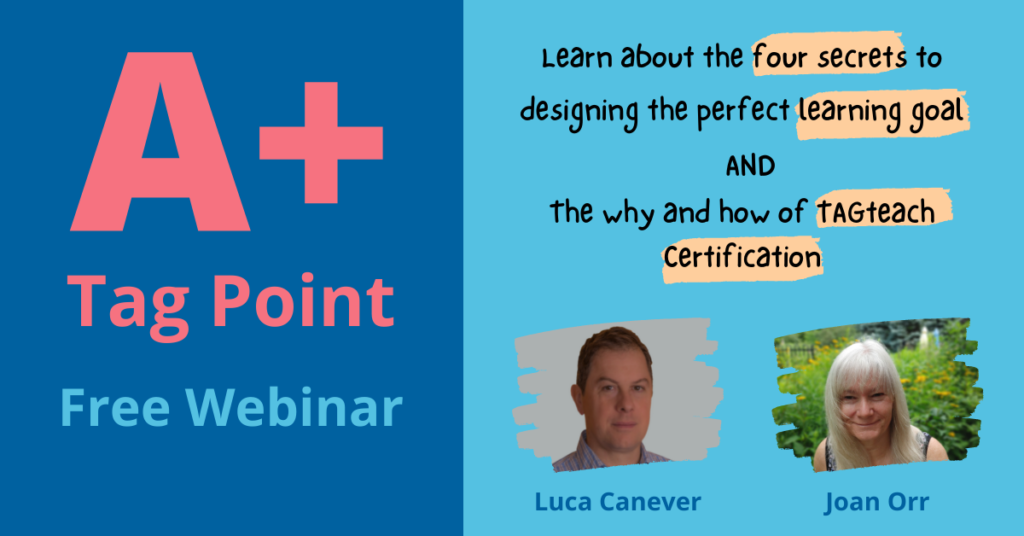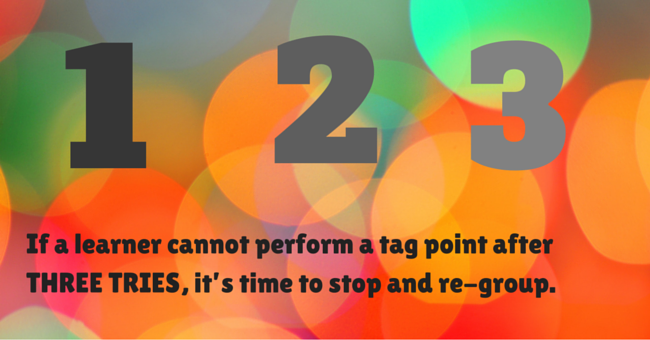By Joan Orr M.Sc., TAGteach Cofounder
How do you feel when you try something and make mistakes over and over? How do you feel when it seems that you are disappointing the person trying to teach you? Do you feel energized and excited to be “learning from your mistakes” or do you feel frustrated and discouraged? Do repeated failure and “just one more”s make you anxious, frustrated and wanting to escape to do something less stressful?
Sometimes the result of too much pressure to try something too hard results in a full-on meltdown or a complete shut down of the learner. Once this happens, there is no more learning.
This is why we suggest the three try rule. If a learner fails three times (or fewer) to meet the specific learning goal (the tag point), go to a past point of success and move forward in smaller increments.
A point of success is something earlier in the learning process that you are 100% sure the learner can get right. By starting at a point of success and moving forward in small steps you build on existing success instead of searching blindly for a good starting point. Of course the ‘three try rule’ isn’t really a rule. The learner doesn’t HAVE to fail three times. If it is clear the learner will not likely achieve the tag point criterion after the first failure, or the learner is very sensitive to failure, jump right in and break the skill down further and change the tag point.
The best designed tag points move the learner forward but don’t ask him to teeter on the brink of failure.
A tag point is a specific learning goal that when achieved will earn the learner immediate positive reinforcement. With TAGteach we use a marker (a click sound usually) to tell the learner “yes, that was right”. This is crystal clear communication that comes at the exact moment the learner meets the goal (the tag point). If the learner doesn’t meet the tag point, then the teacher doesn’t tag and the learner knows to self assess and try again.
How to Apply the Three Try Rule
In Case of an Error
- You observe an error on the tag point (ignoring errors that are unrelated to the tag point)
- You ignore the error (no comments, body language or feedback)
- You think back to the last tag point that was being successfully executed
- You say to the leaner “The tag point is … [insert previous tag point]
- You can preface this with words appropriate for your learner if you wish. For example “OK, let’s try something else”. You can even ask the learner what tag point they want to do next.
- You build back up from there, possibly inserting intermediate tag points if the jump was too large the last time.
When Starting a New Session
We always recommend that you start every new session, and even when coming back from a break, with a point of success. This is a tag point that the learner has had good success with in a previous session. You’re sure that they’ll get a tag on the first trial. If there has been a long break you may choose a point of success that is even 2 or 3 tag points behind the point where you finished the last time. This ensures immediate success at the start of every session and lets you build on that success moving forward.
Are Mistakes Essential for Learning?
Some people have remarked after watching a TAGteach session or seeing some of our videos “they got a tag every time, don’t they need to make mistakes to learn?” The answer is, no they don’t need to make mistakes to learn. A TAGteacher will always try to set the learner up to succeed and never purposely make things too difficult. The whole point of using TAGteach is to create clear communication, encourage focus and build a desire to succeed. When the fear of failure is reduced, the learner can focus on the task at hand. Learners gain skills quickly and without an undue amount of stress.
Video Example #1
Watch this video of the three try rule in action. The learner makes three mistakes in a row. Instead of asking him to try again and risk frustration (and a full-on meltdown) the teacher goes back to a previous tag point and starts to build up again from there.
Video Example #2
Here’s another example. Watch these excellent coaches break down the moves for this athlete. Note that as soon as the learner misses her tag point or starts to show signs of frustration, the coaches make it easier and start from a point of success to build up again.
Learn About the 4 Key Components of a Tag Point (Learning Goal)


Awesome! I am watching this and thinking about how I work with my dog and sooooo know what I need to do now!! Click treat for me!!!
Awesome! I am watching this and thinking about how I work with my dog and sooooo know what I need to do now!! Click treat for me!!!